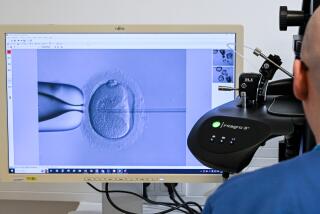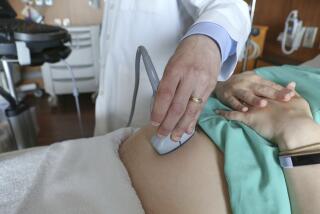Birth by Test Tube Turns 25
- Share via
They came from all parts of Britain, traveling separately and telling no one but their nearest and dearest where they were bound. At night, they lay in the clinic listening as the scientists padded in and out of the laboratory, conducting tests to tell them when each woman’s time had come.
Reporters waited outside like hawks, ready to swoop. Religious leaders decried the experiments, and prominent scientists warned the doctors that they were moving too fast, tinkering with the unknown, risking the health of innocent life.
For the record:
12:00 a.m. Aug. 1, 2003 For The Record
Los Angeles Times Friday August 01, 2003 Home Edition Main News Part A Page 2 National Desk 1 inches; 62 words Type of Material: Correction
In vitro -- A July 24 article in Section A on in vitro fertilization incorrectly stated that biomedical ethicist Leon Kass remained opposed to the procedure after the birth in 1978 of the first IVF baby, Louise Joy Brown. After Brown’s birth, Kass changed his position, finding in vitro fertilization acceptable in the case of a married couple seeking treatment for infertility.
Paul Ramsey, Princeton University professor of religion, called the work “unethical medical experimentation on possible future human beings ... subject to absolute moral prohibition.”
Nobel Prize-winner James Watson demanded: “What are we going to do with the mistakes?”
The product, on July 25, 1978, was not some sinister monster, but simply Louise Joy Brown, the first test-tube baby and an instant sensation. Chubby and yelling, baby Louise could never have been naturally conceived -- her mother’s fallopian tubes were hopelessly blocked, cutting off eggs from sperm.
But egg and sperm did meet -- in a dish, in a lab, in a gray English town -- introduced to each other by the scientist-doctor team of Robert Edwards and Patrick Steptoe.
Today, as Louise Brown approaches her 25th birthday, a once-stupendous and controversial accomplishment has become routine. In vitro fertilization is an outpatient procedure conducted at nearly 400 clinics in the United States alone. More than 1 million people conceived in lab dishes now walk the Earth.
The technology is costly -- $10,000 or more per attempt -- and many couples still leave clinics empty-armed. But the reach of in vitro fertilization has broadened beyond all early predictions, making biological fathers even of infertile men and allowing women well past menopause to bear babies.
In the process, the technology has shed light on many secrets of human reproduction, long kept shadowy by our species’ need to keep egg, sperm and embryo safe in the body. But it also subtly altered our perceptions of what it means to be human -- showing us that life can begin unnaturally, in the coldness of the lab, and lose none of its essential humanness.
It was a risky, uncharted terrain trodden by scientists who thumbed their noses at their colleagues’ disapproval, and women who were willing to take sizable medical and emotional risks, so strong was their yearning for children.
“We knew it might never work, but we all had this one, main thing in common, the desire above anything else in the world to have our own baby,” said 56-year-old Grace MacDonald of Denny, Scotland, mother of Alastair, the world’s second test-tube baby.
“I had decided that this was my priority in life and I would do anything in life to achieve it,” she said. “I would have stood on my head in a corner if they’d said that’s what it took.”
The urge to pass on genes runs deep, and scholars have long pondered the roots of infertility. In ancient Egypt, doctors tested for blockages in women by inserting garlic cloves in their reproductive tracts, then searching for a garlicky smell on their breath. Renaissance physicians prescribed a diet of testicles and livers of young stags to infertile men.
Microscopic View
After centuries passed, sperm and egg were observed directly with microscopes, and scientists came to understand that the two must unite to start new life.
When Robert Edwards began his studies on animal reproduction in the 1950s, scientists had been trying for years to fertilize eggs in test tubes, only succeeding in 1954 with rabbits. Their many failures underscored the subtlety of the process -- the need for just the right milieu of salts, food, acidity and hormones in the culture medium.
That is not the least of the puzzle since each species has its own foibles and those of humans were especially mysterious. “Even as a man walked on the moon, no one knew when a woman ovulated,” Edwards, a tall, unruly-haired biologist, once mused.
It took him years of research, for instance, to learn that human eggs needed about 37 hours to ripen and be ready for fertilization after a signal had been sent from the brain.
A momentous day came in 1968, when Edwards, then a scientist at Cambridge University, and a student added some of their sperm to nine donated eggs -- and witnessed them moving into eggs. “Life is created in test tube,” proclaimed one headline.
It took still more tinkering before the fertilized egg would divide into cells. Edwards even tried growing the embryos in the rabbits, leading to dark rumors in the press about rabbit-human life. New nutrients eventually did the trick -- coaxing fertilized eggs to split into two, four, eight cells, and then into five-day-old hollow balls called blastocysts.
“It was unbelievable,” Edwards recalled, speaking from his office near Cambridge. “There they were, four blastocysts floating lightly in fluid -- four beautiful blastocysts.”
Edwards had begun working with Steptoe, a piano-playing gynecologist who had pioneered a way to look at ovaries using a thin viewing tube called a laparoscope -- perfect for plucking eggs to be fertilized, nurtured and then returned. For a decade, Edwards drove between his Cambridge lab and Steptoe’s clinic in the northern town of Oldham, clocking 250,000 miles. Sometimes, as he drove home, he had fresh eggs strapped to his side to keep them warm until he reached his lab.
From the very beginning, the work was deemed controversial.
“It was all very sort of dubious -- that’s how the scientific establishment regarded it -- there were some big heavyweights, Nobel prize-winners in Cambridge, who were very critical of the program,” recalled Roger Gosden, scientific director at the Jones Institute for Reproductive Medicine in Norfolk, Va., a former graduate student of Edwards’.
Leon Kass, now chairman of President Bush’s council on bioethics, was an outspoken critic of the technology and did not appear to change his mind after the birth of Louise Brown. “Do we not pay in coin of our humanity for electing to generate sexlessly?” he wrote in 1979.
Voices of Dissent
Concerns were of every stripe: moral, philosophical, religious and medical. In vitro fertilization would erode the specialness of life. It would kill embryos -- potential people. Women would participate thinking they would suffer no harm and bear healthy babies, but there was not enough evidence to be sure of this.
But by 1972, Edwards and Steptoe decided they had done enough groundwork to start replacing embryos. Women like Grace MacDonald were more than ready to participate.
MacDonald was a married woman in her early 30s when she first heard about Steptoe and Edwards. She and her husband had been trying to have a baby for 10 years, and after a string of failed operations to unblock her fallopian tubes, she had been told there was nothing more to do. She would not accept it.
“My husband always used to describe me as thrawn -- a really good Scottish word meaning that nobody can tell me I can’t do something,” she said.
One evening in 1975, her husband, James, a musician, was playing his violin at the home of a doctor friend. MacDonald started idly leafing through a copy of a medical journal, The Lancet.
“I just picked it up, thought ‘I’ll have a wee glance at this while I’m listening’ -- it was as odd as that,” she said.
Inside was an article describing the work of Edwards and Steptoe. MacDonald wrote to Steptoe and presented her case. She eventually joined dozens of woman making shadowy pilgrimages to a small cottage hospital on the outskirts of Oldham, a factory town once the international hub of the cotton-spinning trade during the Industrial Revolution. MacDonald’s mother, watching her daughter’s covert comings and goings, was convinced she had cancer and was seeking secret treatment.
MacDonald had an operation to clear away bits of tissue obscuring her ovaries. She gave three to four blood samples a day and dutifully collected every last drop of urine in a bottle so that Steptoe and Edwards could know, from the hormones in it, when her one monthly egg would be ready for harvesting.
Then, when the time was ripe, she lay anesthetized on the operating table, her abdomen expanded with gas, as Steptoe searched for the egg with his laparoscope and plucked it out to be fertilized.
The first time Steptoe inserted an embryo through her cervix into her womb, nothing happened. MacDonald rode back to Glasgow feeling numb.
It was another year before she tried again, for her marriage was stretching thin under the stresses of life and infertility. The next time she was implanted, MacDonald felt different from the moment that the 16-cell embryo was inside her. She soon learned that she was pregnant.
She assumed that hers was one of dozens of pregnancies, because many women were coming and going to Oldham. Already, sensational news of one pregnancy had been leaked to the press. Reporters thronged Oldham, dressing up as janitors, boiler men and hospital administrators in their bid to gain access to the first in vitro mother-to-be: Lesley Brown, a young woman from Bristol.
One by one, other women learned that their bids to have babies had failed. They packed their bags, wished MacDonald good luck and rode home.
There had been only four pregnancies. One woman miscarried several weeks after implantation. The scientists discovered the fetus was abnormal, carrying three sets of each chromosome instead of the normal two. Another woman miscarried after 20 1/2 weeks.
Louise Brown was born close to midnight on July 25, 1978. Alastair MacDonald was born on Jan. 14, 1979, after an exceptionally heavy Scottish snowfall. Straining to keep the secret even as she went into labor, MacDonald gasped repeatedly to the nurse, “I must call Uncle Patrick! I must call Uncle Patrick!” Steptoe arrived through the snow only after she had given birth.
There was an 18-month lull, then a stutter of births -- and finally, an explosion.
Acceptance after the early births was by no means automatic. The first in vitro fertilization clinic in the United States opened in 1980 at Eastern Virginia Medical School in Norfolk, after a hearing packed with busloads of antiabortion activists and medical students, who came in support of the clinic.
Hate Mail
The clinic one day received a picture of Louise Brown in the mail inscribed with the message: “She has no soul.”
Medical unease remained also, despite the slowly accumulating tally of healthy births. The fetus of the first pregnancy at Norfolk had a troublingly small head and on the morning of the scheduled caesarean, clinic director Dr. Howard Jones prepared a statement announcing that the baby was abnormal, and carried it in his pocket to the hospital.
Elizabeth Carr, America’s first in vitro child, turned out to be a normal, healthy child.
Today, the once-sensational has become the routine. On a slow morning in July at USC’s assisted reproductive technologies clinic, eggs have already been taken from one patient and will be harvested from another in half an hour. Now it is time for an embryo transfer.
Senior embryologist Mary Francis, clad in blue scrubs, stands waiting in a small laboratory. Incubators nurture embryos in their commercially manufactured media until they’ve developed their requisite three to five days and are ready for returning to the patients.
To one side sits a microscope linked to a micromanipulator -- a device allowing sperm from men with fertility problems to be injected, head first, into eggs. Elsewhere, tiny embryos sit frozen in liquid nitrogen.
Francis, a 15-year veteran of the craft, pools several embryos into a droplet, washes them and loads them into a slim catheter. She hands the catheter to Dr. Richard Paulson, clinic director. He threads it through the patient’s cervix into her uterus, guided by ultrasound images.
He expels the tiny clusters of cells, then hands back the catheter to Francis, who checks it under the microscope to make sure that the embryos were delivered.
The patient will lie for an hour, then go home.
Normalcy in the clinic has been mirrored by acceptance in society, but not entirely: The National Right to Life Committee says it remains opposed to in vitro fertilization as practiced today because excess embryos are often destroyed or donated to research. Protesters still sometimes tread the streets near the Norfolk medical school.
Ethicists and lawyers have faced some strange legal and ethical puzzles -- from ownership rights of frozen embryos after divorces to parentage of a baby carried by a surrogate but conceived of a dead woman’s egg.
Some are debating whether more controls should be placed on the in vitro profession, which is required by law to report annually to the government but is essentially self-policed.
Issues focus on matters of day-to-day practice: standardizing record-keeping and ensuring clients are adequately informed of their chances. Others are thornier. Should clinics decide whether they will genetically test embryos so parents can choose traits such as the sex of their child -- or should a regulatory board, as in Britain, decree when such choices are acceptable?
In recent years, scientists have detected a slightly increased rate of birth defects and very rare genetic disorders in children conceived in the test tube. Riskier, multiple births -- twins, triplets and even the occasional quadruplets -- still are common, because more than one embryo is generally added back to a patient to improve the chance of pregnancy, which averages about 30% per attempt. Scientists are seeking a way to identify embryos most likely to implant, so they need add back only one.
But Watson’s fear -- of deformed “mistakes” -- has gone by the wayside.
Louise Brown’s unusual beginnings led to lifelong public scrutiny: She was corralled by cameras each time she cut a tooth or walked a step. Weary of the attention, she and her family declined to talk to news media this year except at a “baby party” scheduled for Saturday at the clinic founded by Edwards and Steptoe in 1980.
For Alastair MacDonald, No. 2, life was kinder. After the initial hullabaloo at his birth, the most he endured was the occasional schoolyard query about his ability to climb out of test tubes.
Knew He Was Special
He was 4 when his parents separated. He was 9 when he came to understand why he was “special” and had always known a girl named Louise.
Now he is looking forward to Louise Brown’s party -- since at long last many of the “babies” attending are old enough to think philosophically about their beginnings instead of running off to play.
“I think it’ll be good to gel with everybody,” he said. “At the last party, when I was 16 or 17, to them it was just a day of fun, while to me it was a day of finding things out and asking questions.”
He knows that the technology has now grown ordinary and that everybody, anyway, is the product of incredible chance. But for him, there was that extra layer of chance -- of the violin, the medical journal, the scientists’ work and his mother’s single-mindedness.






